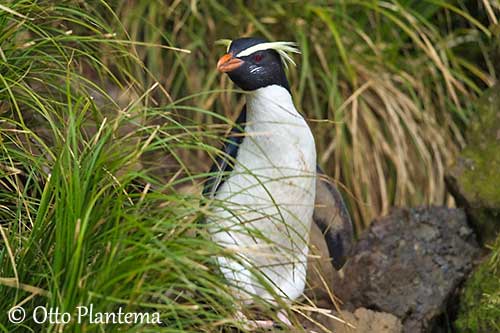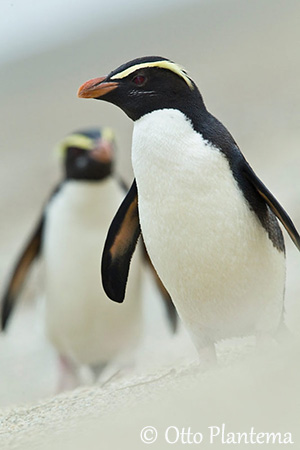
Fr: Gorfou du Fiordland
All: Dickschnabelpinguin
Esp: Pingüino de Fiordland
Ital: Eudipte beccogrosso
Nd: Fjordlandkuifpinguïn
Sd: Nya Zeelandtofspingvin
Photographer:
Otto Plantema
Trips around the world
Text by Nicole Bouglouan
Sources :
HANDBOOK OF THE BIRDS OF THE WORLD vol 1 by Josep del Hoyo-Andrew Elliot-Jordi Sargatal - Lynx Edicions - ISBN: 8487334105
L’ENCYCLOPEDIE MONDIALE DES OISEAUX - Dr Christopher M. Perrins - BORDAS - ISBN: 2040185607
BirdLife International (BirdLife International)
Animal Diversity Web (University of Michigan Museum of Zoology)
PhotoVolcanica - Photography and Information by Dr Richard Roscoe
PENGUINWORLD (Lloyd Spencer Davis)
Welcome to the Penguin Project
Fiordland Penguin
Eudyptes pachyrhynchus
Sphenisciforme Order – Spheniscidae Family
INTRODUCTION:
The Fiordland Penguin is endemic to New Zealand and breeds in the coastal rainforest. It is closely related to the Snares Penguin but some physical and behavioural differences are reported.
The Fiordland Penguin is very shy and mainly active during the night when on land. Outside the breeding season, it is found in the open ocean and shows solitary lifestyle.
This species has small populations (5000-6000 mature birds) and restricted range, and is currently listed as Vulnerable.
This species is also known as Fiordland Crested Penguin.
DESCRIPTION OF THE BIRD:
Biometrics:
Length: 55-71 cm
Weight: 3400-3700 g (up to 5000 g before the moult)
The adult has blue-black upperparts, flippers, tail and head, including chin and throat.
The underparts are white. Flipper underside is pale pink with black edges and tip.
This species differs from the Snares Penguin by white markings or stripes on cheeks, shorter yellow crest and absence of pale pink bare skin around the bill base.
The yellow band starts from the base of the bill and extends over the eye, and droops down the rear of the head.
The red-orange bill is relatively short. The eyes are deep red. Legs and webbed feet are pale pink with black claws.
The Fiordland Penguin is always shy and hesitant outside the vegetal cover, and it tries to remain close to the forest. They are very nervous when humans are approaching, showing flipper and head shivering.
They can be sometimes aggressive towards each other. During encounters, the white cheek markings are conspicuous as the bird puffs the cheek feathers outwards.
They stretch the head or the body forwards with open bill, and hiss before to grab the opponent. They may lunge forwards and both birds grab each other while calling loudly and beating each other with their flippers.
The Fiordland Penguin displays to establish a pair or to strengthen the pair-bonds. Usual displays include vertical and forwards trumpeting associated with head-swinging from side to side.
A mutual display shows the female standing at nest, bowing and moving her bill from side to side. The male responds by trumpeting, and the female joins in crying. They also bow towards each other.
The Fiordland Penguin goes at sea after the fledging period for foraging and to gain weight before moulting. At this period, the weight may reach about 5000 grams. They moult near or at their nesting areas and both mates remain together. This process is complete in about three weeks, and after one week more, they depart again to sea for foraging during the long summer period.
The female lays two eggs, with the second egg larger than the first one. This species displays a form of “brood-reduction”, with only one raised chick from the second egg. The incubation by both parents lasts 31-36 days, with stints of 5-13 days. After hatching, the chick sits on the male’s feet, against the brood patch. The female performs regular foraging trips while the male guards the chick.
After 3-4 weeks, the chick joins a small crèche while both parents forage and return to feed it. The chick fledges in November, 75 days after hatching. It is sexually mature at 5-6 years old.
PROTECTION / THREATS / STATUS:
The Fiordland Penguin is threatened by introduced predators such as stoats, ferrets, rats, cats and dogs which kill the chicks. Human disturbance also reduces the breeding success. Some human developments (roads) may lead to the loss of some nesting sites. Nest failure can also be caused by heavy rainfall.
This species is currently listed as Vulnerable.

Both sexes are similar, but the male is slightly larger than the female, and it has thicker bill.
The juvenile has thinner yellow crest, white throat, grey flecking on cheeks and brownish bill.
The chick has dark brown first down above and whitish below, and similar second down above, with purer white below.
RANGE:
The Fiordland Penguin is found in the Fiordland region, from SW coast of South Island in New Zealand, to the nearby islands of Stewart and Solander. It can be occasionally seen in Tasmania and along the SE coast of Australia, but not for breeding.
HABITAT:
The Fiordland Penguin is marine and pelagic outside the breeding season. It breeds on slopes in the wet coastal temperate rainforest, or in hollows along the rocky coasts.
They feed inshore, usually within their home fiords during the nesting period.
This species spends 75% of its life at sea, and returns to land only for breeding.
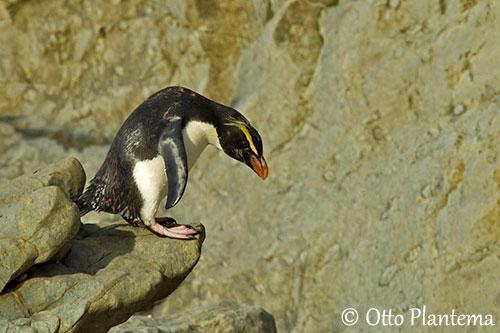
CALLS AND SONGS: SOUNDS BY XENO-CANTO
The Fiordland Penguin has a repertoire of several calls such as “contact call” used at sea, “mutual display call” of 4-5 seconds composed with sounds increasing in length, another sexual call, the “trumpeting call” similar to the previous but starting with a grunt, the “hiss” used during fights is a low-pitched sound ending with a growl, the “bill-locking call” is used in direct physical contact during fights, and the “squeal” is uttered in alarm.
BEHAVIOUR IN THE WILD:
The Fiordland Penguin feeds on squid, krill, crustaceans and small fish. It forages in coastal waters, usually closer inshore than other penguins, and rarely more than 10 km out to sea.
It captures preys by pursuit-diving, and hunts solitary or in small groups. Foraging trips may last about 12 hours.
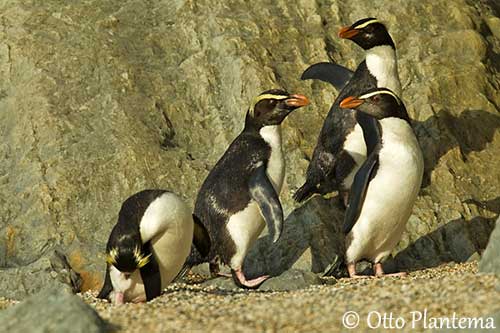
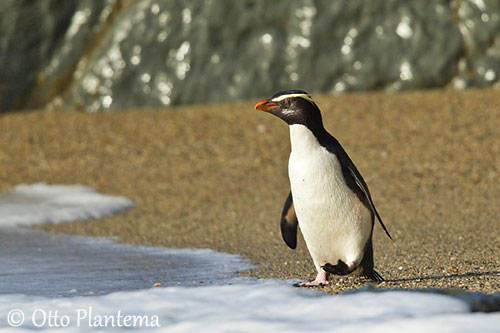
The Fiordland Penguin is dispersive. After moulting, they remain at sea until June-July before to start the breeding season. They can be seen off SE Australia.
This species, like most penguins, is able to walk, climb and scurry on land. In the water, they swim and dive easily.
REPRODUCTION OF THIS SPECIES:
The Fiordland Penguin arrives at colony in June-July, and the laying occurs in July-August.
It may nest solitary or in small loose colonies. The nesting areas are in coastal rainforest, often along the west coasts of New Zealand. The nest is placed in natural hollow, under bushes or overhanging rocks, or between tree roots. The nest is made with very little material and is lined with sticks and some plant material often collected by the male. In soft soil, the nest can be excavated with the feet, or by rotation of the belly. Fidelity to nest-sites is reported.
